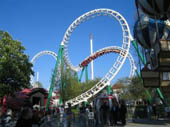
Purpose
To demonstrate how much height a marble will need (when funneled through a foam channel designed to mimic a rollercoaster) to make a complete loop of a certain size.
Additional information
You may need an adult’s help to cut the foam tube and you’ll need a surface high enough to secure the starting point of the “rollercoaster” so it will make a complete loop.
Sponsored Links
Required materials
- 6 feet or more of foam pipe insulation, about 4 cm in diameter
- Knife or sharp pair of utility scissors
- Marbles
- Tape (masking or duct)
- Tape measure
Estimated Experiment Time
One to three days.
Step-By-Step Procedure
- 1. Have an adult help you cut the foam pipe insulation lengthwise and then cut the tube to form two separate types of “slides” for the marble.
- 2. Begin taping the channels together to make a rollercoaster “track” as long as you want.
- 3. Decide on a certain diameter for your loop. You may want to do some research to find out what diameter will work best, but you don’t have to. You can experiment with different diameters to find the best one – just don’t make the diameter of the loop too large or you may not find a height in your house that is high enough for the starting point that will enable your marble to complete the loop.
- 4. Raise the starting end to a high point, such as on a bookshelf, and tape it down. You will also want to tape down the loop and other parts of the track to the floor to stabilize the track.
- 5. For each height, roll the marble down the track 12 times. Does the marble ever complete the loop? If it does, how many times?
- 6. Work with different starting point heights until you find the lowest height that will cause the marble to complete the loop almost all the time.
Note
You may need to experiment with different marble sizes as well to find the best combination of track height, marble weight and loop diameter.
Observation
Once you’ve found the perfect formula, measure the diameter of the loop and the height of the starting point of the track.
Result
After some experimentation, you should be able to find a successful formula for both loop diameter and starting point height to get the marble to roll down the track and complete the loop successfully most of the time.
Sponsored Links
Take a moment to visit our table of Periodic Elements page where you can get an in-depth view of all the elements,
complete with the industry first side-by-side element comparisons!